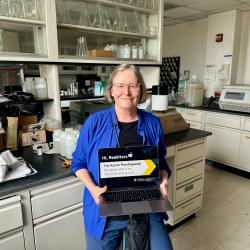Finding Her Perfect Fit: Senior Grace Duke Traded Journalism for Science
Roughly 50 percent of students who declare a major before entering college end up changing their minds—providing further evidence that college can lead students on paths they never considered before. University of Maryland senior geology and atmospheric and oceanic science double major Grace Duke’s college journey took her from reporting the news to studying coral skeletons in New Zealand.
Duke began college with dreams of becoming a foreign correspondent. She took journalism classes, but realized that the idea she had built up in her head of her future career didn’t match what the field had evolved into today, and she slowly lost interest.
In the fall semester of her sophomore year, she took a risk and changed her courses from the humanities to the sciences.
“At the time, I wasn’t sure what direction I wanted to go, so I pursued the Earth sciences and I found my niche,” Duke said.
Her curiosity led her to study past climates, a field known as paleoclimatology, and specifically the change of elements in the air and water across thousands, if not millions, of years.
“Sometimes when you have too many interests, narrowing them down is hard,” said Duke. “Paleoclimatology allows me to explore a complex puzzle because so many different aspects of science are involved.”
Duke’s research focuses on isotopic and elemental variations found within coral skeletons. When Duke’s mentor, University of Maryland Geology Associate Professor Michael Evans, introduced her to Andrew Lorrey, a climate scientist at the National Institute of Water and Atmospheric Research (NIWA), Lorrey invited her to conduct coral research with him in Auckland, New Zealand.
As a coral grows, its skeleton incorporates its surroundings. Looking at the isotopes and elements within these skeletons can reveal a lot of information about the climate and ocean during a specific time. However, even a small amount of diagenesis—the chemical and physical changes coral experience that alter their original skeletal composition and structure—can distort paleoclimate data, so Duke examined coral skeletons to ensure their pristine condition before they were studied.
To check for diagenesis, geologists use petrographic analysis, which takes an in-depth look at the microstructure and properties of a sample. Duke prepared thin sections of coral for petrographic analysis and helped to examine results from preliminary tests. Duke’s New Zealand trip was supported by a 2015 Undergraduate Summer Research, Travel and Educational Enrichment Award from the UMD College of Computer, Mathematical, and Natural Sciences Alumni Network.
When she wasn’t in the lab, Duke hiked through New Zealand jungles, visited the notorious black sand beaches and admired the fauna native to the island country.
“New Zealand is so exotic and fascinating,” she said. “It’s like a jungle, but you wear a light jacket.”
The experience left Duke wishing for a return trip, so she plans to apply to graduate schools in New Zealand. Duke’s experience also taught her an important lesson that she hopes other students keep in mind as they navigate the college experience.
“College is about exploration and figuring out what to do with your future,” Duke said. “Don’t get bogged down with one idea when it doesn’t fit you.”
Media Relations Contact: Abby Robinson, 301-405-5845, abbyr@umd.edu
Writer: Rachael Romano
University of Maryland
College of Computer, Mathematical, and Natural Sciences
2300 Symons Hall,
College Park, MD 20742
www.cmns.umd.edu
@UMDscience
About the College of Computer, Mathematical, and Natural Sciences
The College of Computer, Mathematical, and Natural Sciences at the University of Maryland educates more than 7,000 future scientific leaders in its undergraduate and graduate programs each year. The college's 10 departments and more than a dozen interdisciplinary research centers foster scientific discovery with annual sponsored research funding exceeding $150 million.







